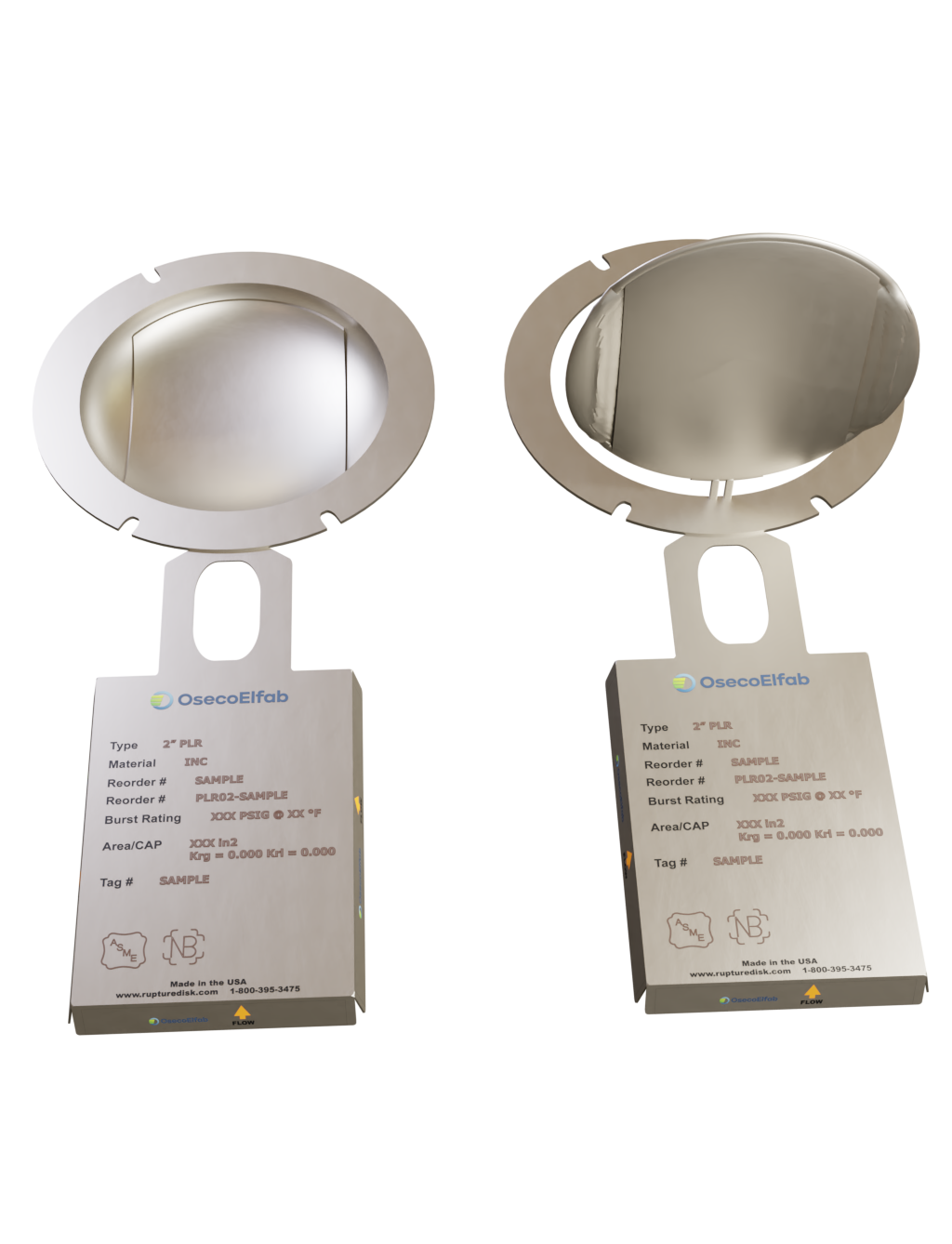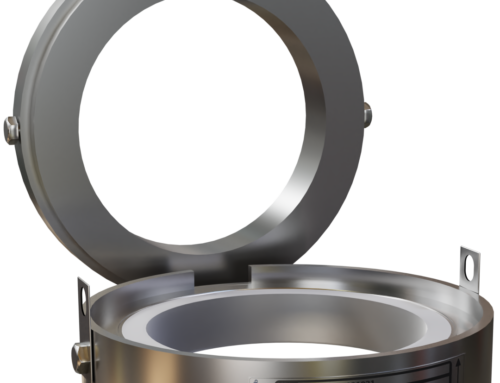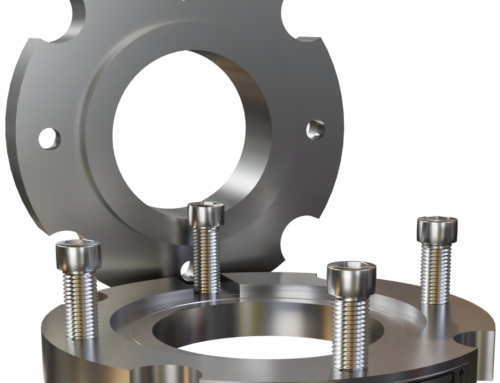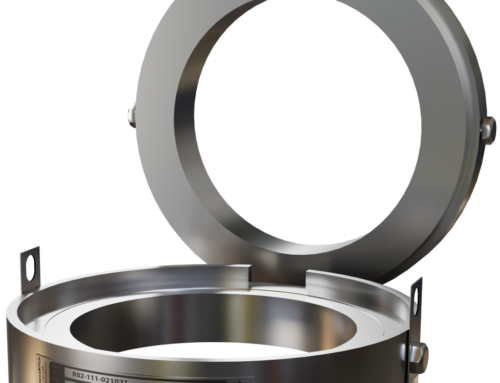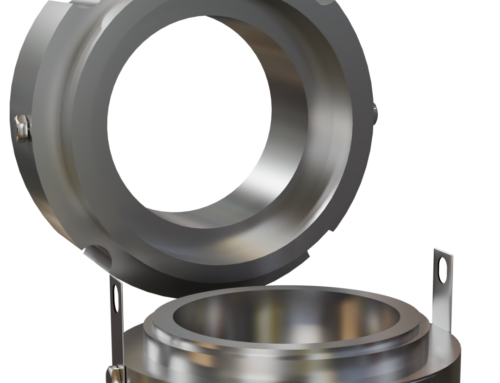OsecoElfab’s PLR Rupture Disc
OsecoElfab’s PLR is a high-performance reverse buckling rupture disc designed for very low pressure applications. The PLR is ideal for gas or liquid applications requiring burst pressures down to 2 PSIG. The PLR features a 90% operating ratio. PLR rupture discs are formed with solid, unscored domes, to which are welded armor plates. An inlet plate with a throwing star shape is welded to the inlet, while a flat paddle with “frog legs” is welded to the outlet side of the PLR. These armor plates ensure the PLR opens under any conditions and does not fragment. The design of OE’s PLR rupture disc yields a high-performance disc able to withstand operating pressures very close to the burst pressure of the rupture disc. The PLR is an excellent choice for isolation of low-pressure safety relief valves.
- The PLR is available in line sizes 1.0”, 1.5”, 2.0”, 3.0”, 4.0”, 6.0”, 8.0”, 10.0”, and 12.0”.
- The PLR is available in burst pressures ranging from 2 psig all the way up to 132 psig.
- The PLR is available in burst temperatures ranging from cryogenic temperatures all the way up to 900 degrees F.
- The PLR is available in all OE standard materials (316 Stainless Steel, Nickel 200, Inconel 600, Monel 400, and Hastelloy C 276). Other materials may be available or offered on request.
- The PLR works well in gas or vapor services, as well as liquid or two-phase services.
- The PLR is not ASME UD stamped, and a default KRGL of 2.4 must be used in sizing calculations.
- The PLR has a 90% operating ratio, meaning the PLR operates reliably and with a long service life at pressures up to 90% of the marked burst pressure. Pressure excursions above this 90% operating ratio will shorten the lifespan of the PLR.
- The PLR is only offered with a 0% Manufacturing Design Range (MDR), meaning there will never be any variation between what burst pressure you order, and what burst pressure is marked on the tag of the rupture disk.
- The PLR maintains a custom burst tolerance of +/- 10% of marked burst pressure for burst pressures above 40 psig, and +/- 3 psig for burst pressures between 5 psig to 40 psig. Below 5 psig, the PLR maintains burst tolerances of +/- 1.5 psig.
- The PLR is a non-scored metal rupture disk, with a non-fragmenting design, meaning the PLR can be installed upstream from a pressure relief valve.
- The PLR does not use a vacuum support. The PLR is designed to handle vacuum services without any additional design enhancements.
- The PLR is a reverse acting metal rupture disk. Process pressure is applied to the convex side of the rupture disk. Increasing process pressure collapses the dome of the rupture disk until the dome inverts, and the metal yields and tears open along the scored lines.
- The PLR, like all reverse acting metal rupture disks, do best in static pressure applications, but also handle pressure cyclic services extraordinarily well. The PLR has been tested in excess of 1,000,000 full scale pressure cycles (0 psig to 95% of marked burst pressure and back down to 0 psig again), with no evidence of fatigue induced failure or alteration of burst pressure.
- The PLR is offered with a PFA liner or shield on the inlet side of the rupture disk, to enhance corrosion protection. This configuration is called the PLR-L
- The PLR is designed, and manufactured to ASME BPVC Section XIII requirements. This design is not available with the ASME UD stamp however.
- The PLR is designed to pair with the PRDI insert holder, as well as the PRDI-P pretorqued insert holder.
- The MNFA for a 1.0″ PLR is 0.602 square inches
- The MNFA for a 1.5″ PLR is 1.493 square inches
- The MNFA for a 2.0″ PLR is 2.735 square inches
- The MNFA for a 3.0″ PLR is 4.984 square inches
- The MNFA for a 4.0″ PLR is 9.148 square inches
- The MNFA for a 6.0″ PLR is 20.79 square inches
- The MNFA for a 8.0″ PLR is 36.0 square inches
- The MNFA for a 10.0″ PLR is 55.4 square inches
- The MNFA for a 12.0″ PLR is 77.7 square inches
- For a 1.0” PLR, the minimum burst pressure is 11 psig, however if a Teflon liner is used, the minimum burst pressure raises to 17.5 psig. The maximum burst pressure is 100 psig but, if fragmentation is allowable, the maximum burst pressure can be extended to 775 psig.
- For a 1.5” PLR, the minimum burst pressure is 6 psig, however if a Teflon liner is used, the minimum burst pressure raises to 11 psig. The maximum burst pressure is 165 psig but, if fragmentation is allowable, the maximum burst pressure can be extended to 775 psig.
- For a 2.0” PLR, the minimum burst pressure is 6 psig, however if a Teflon liner is used, the minimum burst pressure raises to 8 psig. The maximum burst pressure is 118 psig but, if fragmentation is allowable, the maximum burst pressure can be extended to 775 psig.
- For a 3.0” PLR, the minimum burst pressure is 3 psig, however if a Teflon liner is used, the minimum burst pressure raises to 6 psig. The maximum burst pressure is 96 psig but, if fragmentation is allowable, the maximum burst pressure can be extended to 725 psig.
- For a 4.0” PLR, the minimum burst pressure is 2 psig, however if a Teflon liner is used, the minimum burst pressure raises to 4.5 psig. The maximum burst pressure is 91 psig but, if fragmentation is allowable, the maximum burst pressure can be extended to 400 psig.
- For a 6.0” PLR, the minimum burst pressure is 2 psig, however if a Teflon liner is used, the minimum burst pressure raises to 3 psig. The maximum burst pressure is 78 psig but, if fragmentation is allowable, the maximum burst pressure can be extended to 300 psig.
- For a 8.0” PLR, the minimum burst pressure is 2 psig, however if a Teflon liner is used, the minimum burst pressure raises to 3 psig. The maximum burst pressure is 75 psig but, if fragmentation is allowable, the maximum burst pressure can be extended to 250 psig.
- For a 10.0” PLR, the minimum burst pressure is 1 psig, however if a Teflon liner is used, the minimum burst pressure raises to 3 psig. The maximum burst pressure is 50 psig but, if fragmentation is allowable, the maximum burst pressure can be extended to 100 psig.
- For a 12.0” PLR, the minimum burst pressure is 1 psig, however if a Teflon liner is used, the minimum burst pressure raises to 3 psig. The maximum burst pressure is 25 psig but, if fragmentation is allowable, the maximum burst pressure can be extended to 100 psig.

